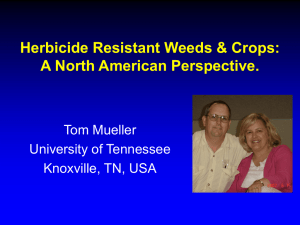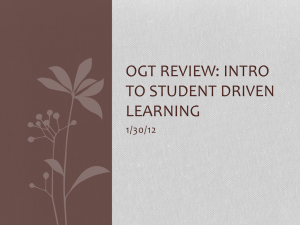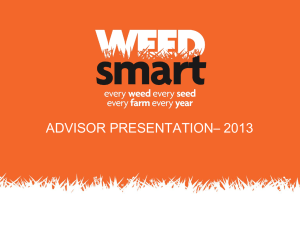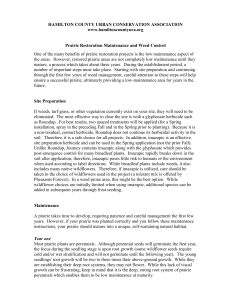Control Techniques handout - Hunter Central Coast Weeds
advertisement
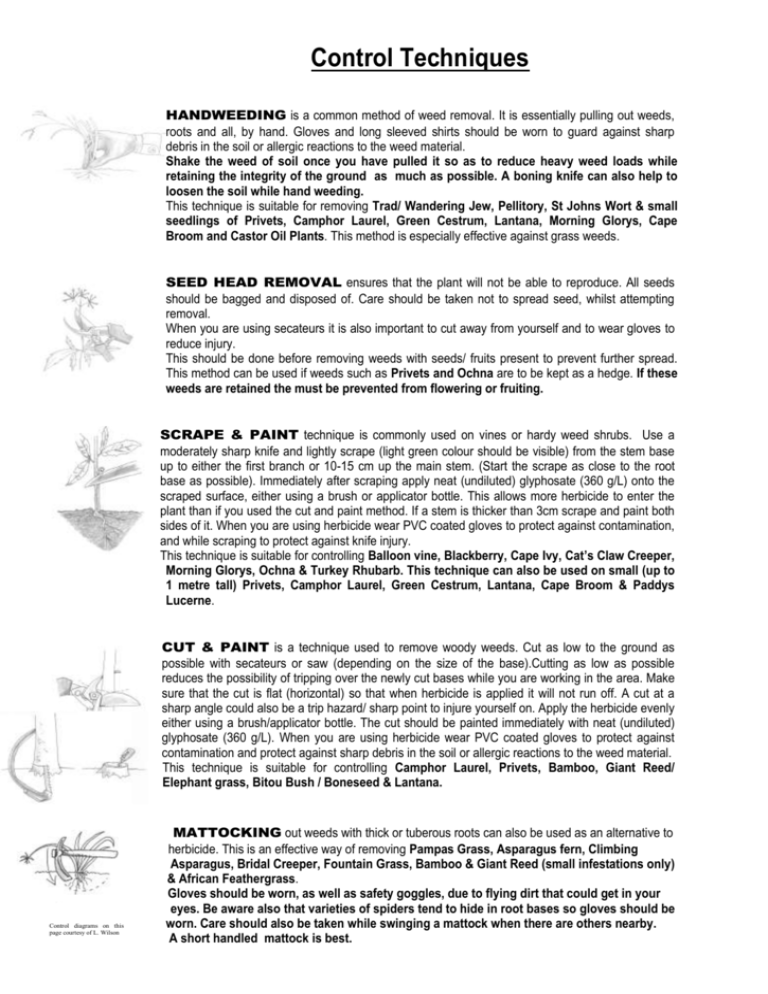
Control Techniques HANDWEEDING is a common method of weed removal. It is essentially pulling out weeds, roots and all, by hand. Gloves and long sleeved shirts should be worn to guard against sharp debris in the soil or allergic reactions to the weed material. Shake the weed of soil once you have pulled it so as to reduce heavy weed loads while retaining the integrity of the ground as much as possible. A boning knife can also help to loosen the soil while hand weeding. This technique is suitable for removing Trad/ Wandering Jew, Pellitory, St Johns Wort & small seedlings of Privets, Camphor Laurel, Green Cestrum, Lantana, Morning Glorys, Cape Broom and Castor Oil Plants. This method is especially effective against grass weeds. SEED HEAD REMOVAL ensures that the plant will not be able to reproduce. All seeds should be bagged and disposed of. Care should be taken not to spread seed, whilst attempting removal. When you are using secateurs it is also important to cut away from yourself and to wear gloves to reduce injury. This should be done before removing weeds with seeds/ fruits present to prevent further spread. This method can be used if weeds such as Privets and Ochna are to be kept as a hedge. If these weeds are retained the must be prevented from flowering or fruiting. SCRAPE & PAINT technique is commonly used on vines or hardy weed shrubs. Use a moderately sharp knife and lightly scrape (light green colour should be visible) from the stem base up to either the first branch or 10-15 cm up the main stem. (Start the scrape as close to the root base as possible). Immediately after scraping apply neat (undiluted) glyphosate (360 g/L) onto the scraped surface, either using a brush or applicator bottle. This allows more herbicide to enter the plant than if you used the cut and paint method. If a stem is thicker than 3cm scrape and paint both sides of it. When you are using herbicide wear PVC coated gloves to protect against contamination, and while scraping to protect against knife injury. This technique is suitable for controlling Balloon vine, Blackberry, Cape Ivy, Cat’s Claw Creeper, Morning Glorys, Ochna & Turkey Rhubarb. This technique can also be used on small (up to 1 metre tall) Privets, Camphor Laurel, Green Cestrum, Lantana, Cape Broom & Paddys Lucerne. CUT & PAINT is a technique used to remove woody weeds. Cut as low to the ground as possible with secateurs or saw (depending on the size of the base).Cutting as low as possible reduces the possibility of tripping over the newly cut bases while you are working in the area. Make sure that the cut is flat (horizontal) so that when herbicide is applied it will not run off. A cut at a sharp angle could also be a trip hazard/ sharp point to injure yourself on. Apply the herbicide evenly either using a brush/applicator bottle. The cut should be painted immediately with neat (undiluted) glyphosate (360 g/L). When you are using herbicide wear PVC coated gloves to protect against contamination and protect against sharp debris in the soil or allergic reactions to the weed material. This technique is suitable for controlling Camphor Laurel, Privets, Bamboo, Giant Reed/ Elephant grass, Bitou Bush / Boneseed & Lantana. Control diagrams on this page courtesy of L. Wilson MATTOCKING out weeds with thick or tuberous roots can also be used as an alternative to herbicide. This is an effective way of removing Pampas Grass, Asparagus fern, Climbing Asparagus, Bridal Creeper, Fountain Grass, Bamboo & Giant Reed (small infestations only) & African Feathergrass. Gloves should be worn, as well as safety goggles, due to flying dirt that could get in your eyes. Be aware also that varieties of spiders tend to hide in root bases so gloves should be worn. Care should also be taken while swinging a mattock when there are others nearby. A short handled mattock is best. CROWNING is another way that weeds with tough root systems or rhizomes can be removed. Using a moderately sharp knife and with a circular motion cut into the soil and roots around the root base. Care should be taken while using a sharp knife so wear gloves, do not leave your knife ‘laying around’ when it is not being used. Also remember your knife is not a lever. A levered knife will usually break. This technique is suitable for removing Asparagus fern, Bridal Creeper & Climbing Asparagus. Control diagram courtesy of L. Wilson DRILL AND INJECT is an effective way to ensure a thorough kill. Holes should drilled at 100mm intervals around the trunk at a downward 45° angle. The herbicide (Glyphosate 360g/L) must be applied within 20 seconds of the hole being drilled. Holes should be about 6mm wide and 25mm deep. If plant is multi stemmed, treat each stem as a separate trunk. Ensure you wear thick PVC coated gloves when doing this. This technique is suitable for controlling Camphor Laurel, Lantana, Ochna, Privets, Rhus Tree and Willows. After tree has died, it is recommended that the tree be removed for safety reasons. FRILLING is another method to ensure a thorough kill. An axe or a wide chisel can be used with this method. The herbicide must be applied within 20 seconds of the cut being made. Ensure you wear thick PVC coated gloves when doing this. This technique is suitable for controlling Camphor Laurel, Lantana, Ochna, Privets, Rhus Tree and Willows. After tree has died, it is recommended that the tree be removed for safety reasons. Above 3 Control technique diagrams courtesy of the National Trust SPRAYING is an effective method for the treatment of some weed species. This treatment should always be carried out in accordance with the label directions. The label on any chemical is a Legal Document. Please read the label before commencing any control work involving chemicals. Follow the label directions for mixing rates and times for application. Personal Care: Glyphosate is a mild eye and skin irritant. Keep your eyes protected when handling neat herbicide. PVC or waterproof gloves need to be worn when using herbicide. Long sleeve shirts, long trousers and covered shoes also reduce skin contamination. All spills onto clothing and skin should be washed off immediately with clean water. For larger spills contaminated clothing should be removed and washed. Wash contaminated clothes and gloves separate to your normal load of washing. For specific advice on controlling weeds not listed on this sheet, contact Wyong Shire Council’s Noxious Weeds & Pest Species Officer on 02 4350 1690 during business hours or email Paul.Marynissen@Wyong.nsw.gov.au

